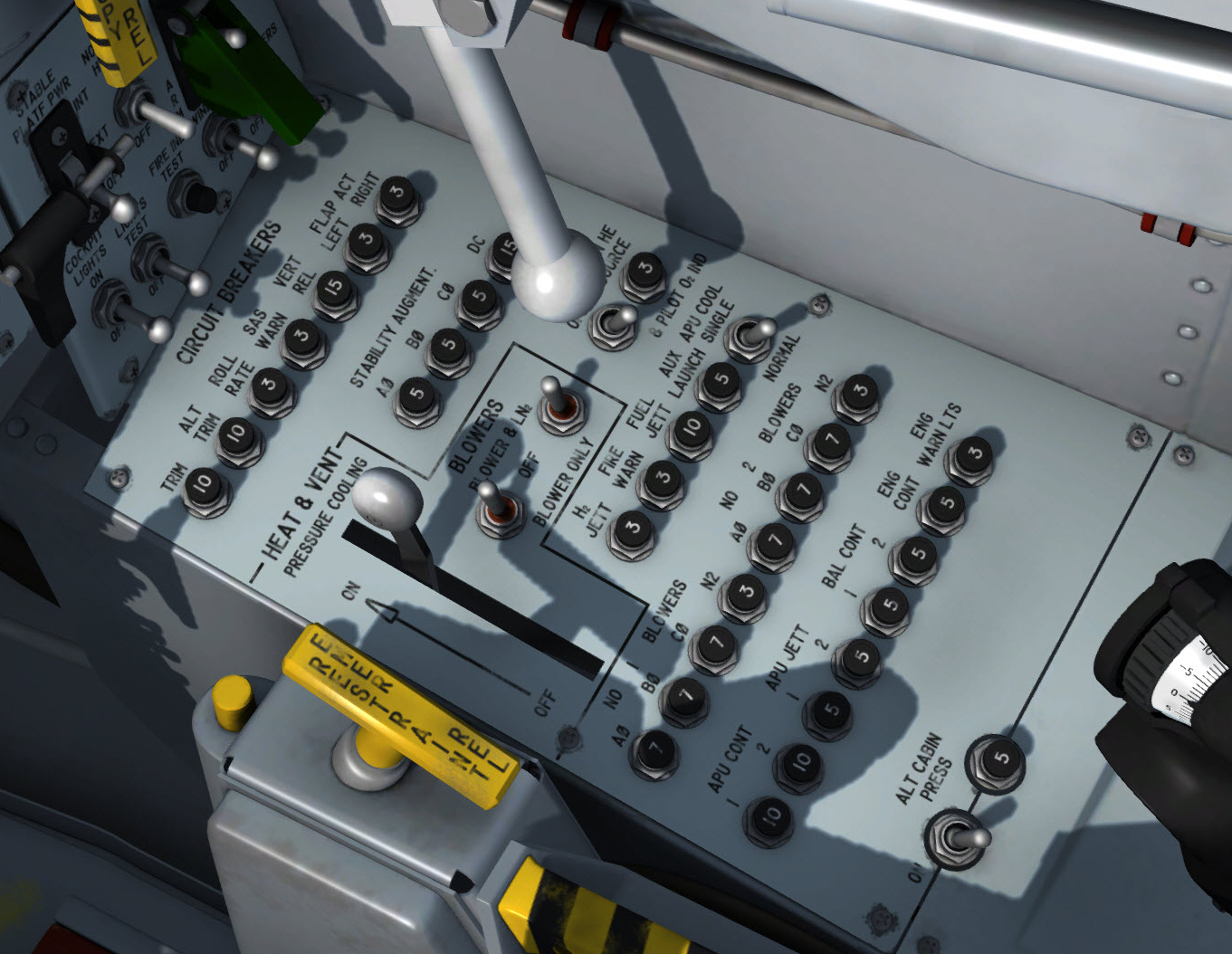
Air conditioning and pressurization system controls on the breaker panel on the right console.
The air conditioning and pressurization system utilizes either liquid nitrogen or ram air as a cooling and pressurization medium.
The liquid nitrogen is supplied from the X-15 storage tank during free flight and from either the X-15 storage tank or the carrier airplane pylon tank during captive flight. The X-15 tank can supply the entire air conditioning and pressurization system and when used will supply liquid nitrogen for pressurizing and cooling the cockpit and No. 2 electronic equipment compartment, and for cooling for the AC generators, APU upper turbine bearings, stable platform, and ball nose. It will also supply nitrogen gas for inflating the canopy and equipment compartment seals, purging the hydraulic reservoirs, between-panel purging of the windshield, and ventilation of the pilot's pressure suit.
The nitrogen gas used for between-panel windshield purging and pilot's pressure suit ventilation is supplied through a common liquid nitrogen supply line which contains a heat exchanger and electric heater for converting the liquid to gaseous nitrogen.
The carrier airplane pylon tank and associated controls make up the augmented cooling system. The primary function of this system is to augment the cooling to the stable platform during ground operation and taxiing, when the blowers are circulating compartment air, and when ram air is used during climb to cruise altitude. The augmented system is also used for between-panel windshield purging and pilot's pressure suit ventilation during these times and can be used for cooling the No. 2 electronic equipment compartment and ball nose.
The ram-air system is limited in its operation to cooling the cockpit and the electronic equipment compartment. The ram-air system, with augmented cooling, is used during climb and cruise. The X-15 liquid nitrogen system is turned on at the beginning of cruise-climb to launch altitude.
Note: If the ram-air system does not provide adequate cockpit cooling during captive flight at altitude, the augmented cooling system liquid nitrogen supply can be used to increase cooling by turning off the ram-air system and turning on the blowers.
The ram-air system should not be used above 35,000 feet or at speeds in excess of Mach 1.0, because of possible damage to the ram-air scoop [21, fig. 3-1] and ducting due to high or excessive air loads and temperatures too high for proper electronic equipment cooling. During free flight, ram air may be used as an emergency measure if the X-15 liquid nitrogen system fails or during descent when the liquid nitrogen system has been depleted, but the limitation of Mach 1.0 must be observed.
The cockpit and the electronic equipment compartment are pressurized to 3.5 psi by the use of nitrogen after it has been converted from liquid to gaseous state. The X-15 liquid nitrogen is stored under pressure and is converted as required for cockpit and equipment cooling and pressurization. A cockpit pressure regulator automatically maintains a pressure of 3.5 psi at 35,000 feet and above. From the ground up to 35,000 feet, the cockpit pressure remains the same as the outside pressure. If the cockpit pressure regulator does not operate properly, a cockpit safety valve will not allow the cockpit pressure to exceed 3.8 psi; also, during a rapid descent, the safety valve will prevent a pressure differential greater than 0.5 psi.
Pilot comfort is provided by the David Clark A/P22S-2 pressure suit, which maintains a regulated pressure of 3.6 psi over the entire body. Pressure to the suit is provided by the air conditioning and pressurization system. Temperature control of the nitrogen flow through the suit is maintained by an electric heater which is adjusted to a pilot-selected range. The temperature of the gas supplied to the pressure suit is from 55°F (±5°F) to 90°F (±5°F).
The X-15 air conditioning and pressurization system may be considered automatic to the extent that once it has been started and manually regulated for desired flow and temperature, it will continue to operate without further adjustment.
In this section:
Cockpit Air Conditioning and Pressurization
Air Conditioning and Pressurization System Controls and Indicators
Operation of Air Conditioning and Pressurization System
Generator and APU Cooling and Pressurization